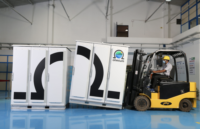Jason F. McLennan, who propelled a global ultra-green building movement, has joined Perkins&Will as its chief sustainability officer and managing director of its 28th studio, McLennan Design, on Bainbridge Island, Wash.
McLennan is the creator of the 15-year-old Living Building Challenge, considered the world’s most rigorous green building certification program, and co-author of the WELL building standard and several other sustainable-building programs.
He won ENR's 2016 Award of Excellence for turning the Living Building Challenge—the first green building program to require levels of performance for certification—into a global movement and for galvanizing hundreds of building teams to raise the bar for sustainability.
The merger of the 10-person McLennan Design, which primarily provides ultra-green building consulting services, into the 2,400-person Perkins&Will—the world’s second-largest architecture and design firm—signals McLennan’s interest to scale up development of carbon-neutral buildings, out of concern that the green-building movement is not getting the traction it needs to help win the fight against climate change.
“I’ve always been looking to have the biggest impact in the world,” says the 48-year-old McLennan, who wants to be part of “a bigger ship to make change.”
Perkins&Will CEO Phil Harrison calls McLennan “a very powerful voice” in the green buildings arena, with the integration of his firm allowing the innovator “to exercise his talents on a larger platform. We hope 1+1 will equal 7.”
Perkins&Will's First Chief Sustainability Officer
McLennan is Perkins&Will’s first official chief sustainability officer, which signals that for the firm, “sustainability is as important as financial performance, technology and people,” says Harrison.
Perkins&Will, owned by Dubai-based Dar Group, is McLennan's choice for a bigger ship, based on its expansive global client base and commitment to sustainable buildings. The architect ranks at No. 33 on the current ENR Top 500 Design Firms list, reporting $572.5 million in 2021 revenue.
McLennan calls the move a good fit for both firms' cultures and values. “Perkins&Will has been a leader in sustainability for years,” he says, declining to provide any financial details of the merger.
For more than a decade, Perkins&Will has been involved in climate action strategies around the world. Since signing the AIA 2030 Commitment in November 2011, the energy efficiency of the firm’s built projects increased on average, by 27%, says the firm.
In addition, Perkins&Will has taken steps to track, measure and offset the operational carbon emissions of its own real estate. As a 2021 signatory of the World Green Building Council’s Net-Zero Carbon Buildings Commitment, Perkins&Will pledged whole-life-carbon reduction for every one of its owned and operated offices by 2030.
The firm has also been involved in other sustainability efforts, including the development of the Embodied Carbon in Construction Calculator (EC3).
The two firms have history. As the former chairman and CEO, and current board member, of the International Living Future Institute, which develops and administers the Living Building Challenge, McLennan says he “cheered on ” Perkins&Will during its early Living Building projects.
Pacific Northwest's First Carbon-Neutral Academic Facility Coming
Recently, McLennan Design partnered with Perkins&Will to design Western Washington University’s Kaiser Borsari Hall. Set to open in 2024, it will be the only carbon-neutral academic facility in the Pacific Northwest, according to Perkins&Will.
The university project helped Perkins&Will introduce a prototype of its new “carbon forecast”—an analysis of a building’s whole-life carbon impact along with design strategies to optimize its sustainability profile.
Over the next year, McLennan Design staff will work closely with firm leadership and individual project teams to partner with clients around the world seeking the most innovative, regenerative design solutions. It will also create tools that facilitate regenerative design and planning across all Perkins&Will’s studios.
In addition, McLennan Design will expand and advance firm-wide programs that enable significant decarbonization of buildings, to help the buildings sector meet its AIA 2030 targets early, says Perkins&Will.
There will also be efforts to lead research into habitat impacts, biophilia and nature-based architectural solutions and to expand consulting on net-zero operational carbon and lower embodied-carbon buildings, as well as healthy materials.
McLennan, who spent decades fighting the construction industry establishment, has decided the best way to move the green-buildings movement forward is to join it.
In launching his Living Building Challenge in late 2006, he sent shock waves through the green building establishment because people thought it too difficult and expensive to achieve. But after some easing of the program and thanks to some pioneers, models started springing up, including Seattle's Bullitt Center and more recently, the PAE Living Building in Portland, Ore.
Currently, clients are asking for greener buildings, McLennan says. “In the old days, it was a harder sell,” he notes.
While great strides have been made, including the first net-zero operational carbon sports facility—the Climate Pledge Arena in Seattle—there is much more work to be done, including improved benchmarking tools for life-cycle analysis of a building’s embodied and operational carbon, says McLennan.
“We can’t sit on our laurels,” he adds. “All of us together need to figure out how to scale this.”





Post a comment to this article
Report Abusive Comment